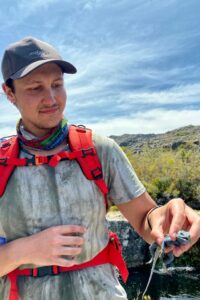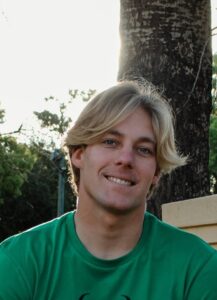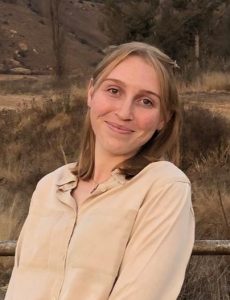MSc Students

Nosipho Gqaleni
Department of Botany and Zoology
Nosipho is studying the seasonal patterns of rainfall, soil moisture and related ecosystem water use efficiency in a semi-arid Nama Karoo landscape comprised of dwarf C3 shrubs and C4 grasses. Her study focuses on determining whether the soil moisture regime and related vegetation evapotranspiration response in the Eastern-Karoo is driven by rainfall seasonality or by specific rainfall events. She aims to describe the seasonal patterns of ecosystem evapotranspiration and determine the most efficient model to predict evapotranspiration from climatic data. She will also be developing a bucket model for this system to simulate soil moisture patterns at two depths. Her study intends to fill the knowledge gap about soil moisture regimes and ecosystem evapotranspiration in this semi-arid region.

Josh Smit
Department of Botany and Zoology
I am originally from Zimbabwe and attended Falcon College for high school. Later, I pursued my undergraduate and Honours degrees at the University of Pretoria. My Honours Project focused on how Nile Crocodiles respond behaviourally to changes in their external environment, and what temperature changes determines their micro- and macro-scale movements. I have since relocated to pursue my Master’s degree at Stellenbosch University, under the supervision of Prof Susana Clusella-Trullas.
My research will focus on the relationship between integument colour, body temperature, and behavioural thermoregulation in a cordylid species in the Western Cape, South Africa. I aim to uncover how short and long-term temperature changes influence melanin-driven colour patterns. By examining coastal and inland populations, my project seeks to expand previous findings and understand colour variation across different environments. Using refined experimental methods, including marking individuals for longitudinal studies, my research also aims to provide insights into how ectotherms adapt to environmental cues. Ultimately, it contributes to understanding colour variation and its adaptive significance in response to dynamic environments.

Gerhard Wiese
Department of Botany and Zoology
Gerhard is a MSc student within the CL•I•M•E research group focusing on lizard physiology, specifically temperature effects on their rates of water loss. Using flow-through respirometry he is measuring the amount of water vapor expelled through the skin and the respiratory system of the lizards. He is also aiming to determine how the partitioning of water loss differs with increasing ambient temperatures. Physiological studies, such as those measuring the temperature sensitivity of water loss rate, are important for understanding how these organisms respond to environmental conditions experienced in nature. Relating these water loss rates to temperature and body size will provide key information for enhancing predictive mechanistic models of vulnerability of lizards to climate change.

Erin Ramsay
Department of Botany and Zoology
Erin grew up in East London in the Eastern Cape. She has both and undergraduate and honours degree in biodiversity and ecology from Stellenbosch University. She has always been interested in climate and global change, which was fostered through working with the School for Climate Studies here at Stellenbosch University. She has worked studying Protea physiology through varying climatic conditions and is now broadening her knowledge through her M.Sc., working with various Eucalyptus species. This is a collaborative project between the Global Change Biology Group and EucXylo labs under the supervision of Prof Guy Midgley and Dr David Drew, where she is investigating how competition influences the physiology of a number of Eucalyptus species through the lens of their respective bioclimatic niches.

Tiaan Engelbrecht
Department of Botany and Zoology
Tiaan is a Master’s student in the department, with his studies mainly focussed on the coastal vegetated ecosystems found along South Africa’s coastline. These coastal vegetated ecosystems include mangroves, salt marsh, and seagrass, and are widely known as blue carbon ecosystems as they capture and store atmospheric carbon in their belowground sediment. His project is focused on salt marsh and seagrass habitats in the Olifants River Estuary on the west coast of South Africa. More specifically, his project entails the measurement and quantification of organic carbon stocks within the sediments of these two vegetation types. Along with measuring the carbon stocks, his project aims to determine the factors that contribute to the variability of carbon stocks across small (0-15 m), medium (50-150 m), and larger (1-3 km) scales, as well as the seasonal variation associated with the carbon stocks. The seagrass species incorporated in his study, Z. capensis, is the dominant seagrass species in South Africa, and is also an endangered species. His study intends to contribute to the limited research and lack of knowledge regarding carbon storage and variability between vegetation types in South Africa, and provide carbon stock estimates required for future carbon budgets. An interesting addition to his project, is the incorporation of subtidal seagrass meadows, which hasn’t been done in previous studies due to difficulty of sampling and accessibility.

Jessica Howard
Department of Conservation Ecology and Entomology, Centre for Invasion Biology
I am a MSc student in Conservation Ecology at Stellenbosch University with a strong background in the Proteaceae family. I completed my undergraduate (Botany and Zoology) and BSc Hons degree (Botany) at The University of Johannesburg where I worked on two Proteaceae related projects, one of which was an independently developed honours research project. These projects helped me develop my love and passion for this family and their amazing adaptations and structures, which ultimately led me to the Western Cape. My research focuses on the Fynbos biome, which is a biodiversity hotspot. Here, ecosystem functioning strongly depends on shrubs of the genus Protea. The recruitment (the transition from seed to established plant) phase of these plants’ life cycle is the most vulnerable, and recruitment strategies differ between genotypes from different environments which are driven by natural selection. Understanding this differentiation in recruitment is crucial in determining how climate change will impact plant population and community dynamics as well as biodiversity. Once understood, conservation management strategies can be developed to mitigate these impacts. To address these challenges, my current project studies the functional and evolutionary determinants of recruitment differentiation between Fynbos Protea individuals, populations, and species. This research makes use of a large common-garden experiment where seeds from 959 mother plants of 195 populations and 18 species were planted. I am using this experiment to quantify variation in germination, performance and functional traits of the Protea seedlings. This MSc is the first of many planned projects, as monitoring of the plants is planned for a minimum of 10 years, aiming to provide long-term data that will contribute to climate change and conservation management research.

Aletta Kassier
Department of Botany and Zoology
Aletta did her undergraduate in Biodiversity and Ecology at Stellenbosch University in 2023. In 2024, she completed her Honours degree which led her to joining the CLIME lab of Prof Susana Clusella-Trullas. Her Honours project focussed on discovering the diversity of lady beetles (family: Coccinellidae) found in the Western Cape, South Africa. Lady beetles are economically important by being fantastic biological controls of crop pests such as aphids, mites, and scales, and are a highly understudied family of beetles in Africa. For her Masters in 2025 and 2026, her project will still be focused on analysing the diversity of lady beetles found in the Western Cape (Chapter 2) but due to a lack of taxonomic keys available in the literature on native lady beetle species, the identification of species is more difficult. Therefore, the first chapter of her Masters’ project will focus on using DNA barcoding and GenBank to identify lady beetle species especially species that have little information available in the literature.
